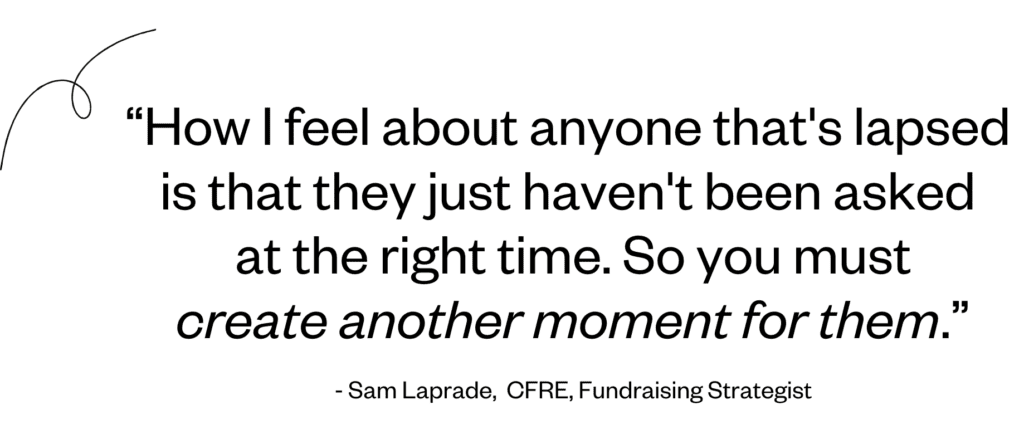
The thought of finding new donors can be daunting. But here’s the thing – often the best place to find more donors is right under your nose, in your own database.
The value of your donor database cannot be underestimated. It contains a wealth of information about people who you have shown interest in your mission. Maybe not all of them have given, but they are already connected to your organization in some way (maybe they are on your emailing list, a past donor, or someone who has attended one of your events, for example). There are many ways to engage with these people and effectively bring them in as donors.
This was a key message that came from a conversation between T. Clay Buck and Sam Laprade on our year-end webinar series. They discussed a variety of tactics that help fundraisers find more donors quickly, and we’ve compiled our top 9 highlights from the webinar to share with you here.
Tactic 1: Fish in your own pond
It’s important to regularly analyze your database in order to identify changes or trends and to keep an eye out for new opportunities. Screening your database can tell you so much about your donors, including opportunities for growth. People’s giving capacity and propensity shifts all the time, so if possible, you should have alerts set up in your prospect research tool so new opportunities are flagged when they arise. It’s also important to invest in a robust CRM that is integrated with your other nonprofit software so that you can easily segment donors, track communications, and personalize outreach based on real-time information.
Tactic 2: Reconnect with lapsed donors
Lapsed donors are the perfect group to reconnect with when you are focused on finding donors. These people have been connected to your organization in the past… perhaps just not recently. Re-engaging lapsed donors is an important part of a long term engagement strategy, and bringing back lapsed donors is much more cost-effective than acquiring brand-new ones.
The key here is that many lapsed donors don’t stop donating for a conscious reason. There are lots of reasons why individuals don’t give every single year, and it doesn’t mean they don’t care about your cause. Often, they have simply forgotten or haven’t been asked.

Tactic 3: Segment and personalize!
Not all donors are the same, so you need to avoid lumping them all together. They don’t always share the same motivations or interests, and they certainly don’t all have the same giving capacities. Just think, you wouldn’t send the exact same birthday message to every one of your friends. The same principle goes for your donors.
Segment your database into distinct groups based on factors like giving history, donation amounts, and engagement levels. This data driven proces becomes much easier and efficient when using a robust prospect research tool and CRM. You can give each group specific types of communication, different requests, and messaging that will align more with their preferences and capabilities.
This will allow you to craft more personalized messages that will resonate more with each audience. Reference the donor’s last gift amount, their preferred giving methods, use their name, their interests, or any other relevant information you can bring in to show that you see them as an important individual.
Tactic 4: Launch a “miss you” campaign
Launching a “miss you” campaign is a great way to show donors that they are valued and, well, missed. This language specifically creates a feeling of personal connection and evokes a sense of shared history. Think of the last time an old friend reached out to say they missed you. It’s likely that put a smile on your face; likely you wanted to respond in kind. This is the type of moment you can try to create for your lapsed donors. Be sure to use a warm and welcoming tone when doing this, and emphasize that the donor’s absence has been felt.
Tactic 5: Highlight missed opportunities
Show how your organization has progressed and the positive outcomes that have come to fruition because of donors’ support. This subtly highlights the things that they missed out on by not being a part of your mission this year, specifically, the impact their donation could have made. This is a way to remind them of their potential impact and emphasize their very real role in your organization.
Tactic 6: Show the power of a single donation
Show the impact a single donation can make. This means using personal stories and anecdotes to illustrate how individual contributions can transform lives. Stories about individual gifts making a difference can be a powerful tool, bringing it to a personal level that can be understood by individual donors.
Tactic 7: Connect to shared experiences
Make your messages relevant by tying them to current events or shared experiences, such as the impact of COVID-19 or economic uncertainty. This is a way to acknowledge the challenges donors and the broader community are facing, and demonstrate how your organization is helping to address them. This creates a connection and sets the tone that you are in this together.
Tactic 8: Use two-way communication
Many say that donor fatigue is at an all-time high and there are so many factors that contribute to donor fatigue. The reality is, though, that if a donor truly cares about your mission, they won’t tire of hearing from you. What they may tire of is solely being asked for donations all the time.

It’s important to have two-way communication and engage in a conversation with your donors. Not every communication has to have an ask attached to it. As counterintuitive as this sounds, in the long run, it will create more genuine connections between you and your donors. This is a prime place for you to talk about the impact donations have made on your cause this year, or just thank them.
Tactic 9: Layer your communications
It is important, now more than ever, to communicate with donors in multiple ways over multiple channels. You can’t just rely on one method and expect it to hit your target audience. Using a combination of email, direct mail, phone calls, and social media gives you the best chance to reach your donors. Some donors may prefer email, while others appreciate a handwritten note or phone call. Combining multiple channels increases your chances of reaching donors and staying top-of-mind. For example, sending a letter teasing a phone call and then following up with that call can personalize the experience. These extra touches go a long way for donors and help them to feel seen and truly engaged.
When finding donors, the most important step is to mine the gold in your own database. You can segment and employ a whole host of tactics to engage with your potential donors in an authentic, conversational, personalized way. You can show them the impact they can have on your cause and the role they play in your organization.
Here are some final words of wisdom from Sam Laprade on the topic:

Be the first to read our resources.
The world is changing quickly—and our resources help you stay on top of it all. Sign up to get new insights, success stories, and more, sent right to your inbox.




